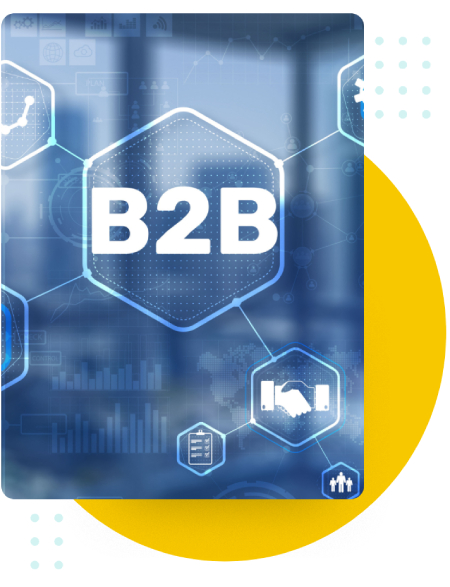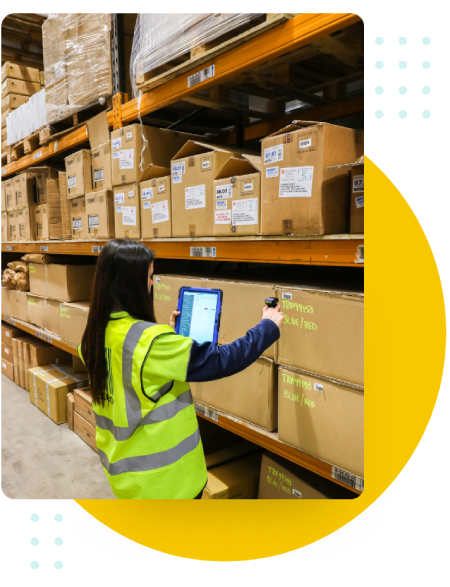Meet Canary7
The Definitive Guide to Ecommerce Inventory Management
Everything you need to know about eCommerce Inventory Management in one place.
Everything you need to know about eCommerce Inventory Management in one place.
The Definitive Guide to eCommerce Inventory Management is here to help you manage eCommerce inventory with absolutely no hassle. The following sections cover all the important aspects of eCommerce, eCommerce inventory management, and the leading eCommerce inventory management solution.
Contents:

In the 21st century, eCommerce is the most powerful tool for any business.
Whether you are a start-up, a small business, or a well-established large corporation, eCommerce can take your operations to stunning heights of success. It helps you expand your reach, build better relationships with your customers, and outsmart your competitors: all in one go, with a single website.
The catch?
Since eCommerce is a relatively newer business model, it relies on the latest technology and strategies to be executed properly. This means that the backend of your business is at the risk of not running as smoothly as it should. To put it simply, eCommerce can really, really complicate logistics, warehousing, and inventory management processes.
But just because eCommerce inventory management is hard to achieve doesn’t mean you should give up on it entirely. In fact, if you are looking to leverage eCommerce as an instrument to propel yourself forward in your industry, you have to pay extra attention to eCommerce inventory management.
Before diving into eCommerce inventory management, it would be useful to take a look at the eCommerce industry. Knowing the eCommerce industry inside out can help businesses in the 21st century understand the value of eCommerce as a tool of success, as well as properly weigh the risks and cons of transforming into an eCommerce brand.
Starting with the very basics: what is eCommerce?
The definition of eCommerce is dependent on what the word means. ‘eCommerce” stands for electronic commerce and is linked to the practice of selling your products online either on a designated shopping platform like Shopify, or on an extension of your own website. (fun fact: the eCommerce inventory management Shopify requires can easily be done using an eCommerce inventory management software – but more of that later.)
Although the main connotation of the word “eCommerce” is linked to shopping platforms, we must keep in mind that the word is not restrictive in any sense. In fact, in today’s time and age, eCommerce has a broad meaning. It includes not only shopping websites and retailers, but also online banking, software services, online course platforms, online services – anything and everything. Virtually every translation made in the online world is a part of the eCommerce realm, and in fact contributes towards the eCommerce economy.
Increasingly, eCommerce is being used as an example of how easy and simple life has become thanks to the Internet. Shopping online is now not only the norm, but also a glaring testament to the fact that technology today strives to bring more convenience to everything that we do.
In actuality, convenience is just one benefit you get from eCommerce – there are many others, including the cost and security factors. Let’s turn to these three main benefits of eCommerce now:

In light of the benefits it brings to the table, you’d be surprised at how amazingly cost-efficient eCommerce is. If you are looking to launch your eCommerce store, you can do it in the cheapest way possible by using platforms like WordPress, Magento, and Wix.
You certainly do not have to make a very large investment to ensure the success of your eCommerce. Infact, you can do it completely free of cost as well if you engage in social selling and set up an Instagram/Facebook store. All you need is stock, sound knowledge of the eCommerce world – and of course, some savvy eCommerce inventory management tools!
eCommerce is cost-efficient for customers as well. If you are buying something online, you have a much better chance of finding a cheaper deal on it than physical shopping. eCommerce makes buying second-hand and thrifted items a lot easier as well, so even customers can save a few precious pennies on their transaction by engaging in eCommerce!
eCommerce is safe: both for businesses and for customers. The minimization of human interaction means that you don’t have to reveal your identity when making a purchase, which encourages people into buying whatever they want. It also makes the whole buying process considerably less invasive, which encourages people even further into making their purchase.
If you encrypt and secure your eCommerce experience properly, the whole thing is secure for you as a business owner as well. This is especially true if people choose to pay online: you don’t have to worry about getting your payments on time, since each transaction will go right into your bank account without you having to do much.
With eCommerce, business owners have better tactics to prevent themselves from identity theft, fraud, and even theft. The fact that everything, for the most part, is traceable and recorded on the Internet in one way or the other proves to be a necessary safeguard for any business operating online.

Let’s look at how the above-mentioned eCommerce benefits show up in the stats around eCommerce:
The next thing that is important to know about eCommerce is the types of eCommerce businesses there are. There are 6 main types of eCommerce models, and in this section, we will take a close look at each of them.

In this business model, the two parties involved, i.e. the buyer and the consumer, are both businesses. Confused? Let us make it easier. Let’s say you are an eCommerce retailer, looking for the best eCommerce inventory management solution. You come to us, Canary7, to get these solutions and finalise your purchase online. The transaction that takes place between us will be a B2B eCommerce transaction.
In simple terms, a business that sells its products and services to another business is based on a B2B model. This doesn’t always mean that the end user of the product is the buyer – it can be a consumer in some cases. Nevertheless, if the main transaction takes place between two businesses, it is a B2B transaction.
B2B selling is becoming more and more important with each passing day. It is quite a lucrative business model to adopt and is hence one of the most prominent eCommerce types out there!
This is the type of eCommerce that most of us are very familiar with. For this business model, businesses directly sell to the end-user. Although there are many different approaches to such a model, the main thing about a B2C transaction is that it is a direct one between the seller and the ultimate user of the product/service in question.
So, anything you purchase from a retailer online: food, furniture, clothing, gadgets – every single purchase is a B2C transaction. These kinds of purchases are the easiest to make, and hence B2C sales cycles are the shortest. What this means is that sellers don’t even have to spend a lot of money on marketing and advertising with these items, which makes B2C even more lucrative.


This type of eCommerce is also very prevalent. As a business model, C2B allows people who are more commonly consumers to sell their goods and services to companies. So, think of platforms like Upwork and Fiverr that allow freelancers to bid for business opportunities they want to be a part of. Not only that, but the rise of influencer culture and influencer marketing is also because it is based on an efficient business model i.e. C2B eCommerce.
C2B is also a very popular eCommerce model as it is a win-win situation for everyone involved. Individuals get to have full control over the work they get, whereas business can benefit from easy talent acquisition at comparatively lower rates.
C2C businesses are those that connect different consumers and allow them to exchange goods and services between each other. So eBay, Craigslist, and so many other platforms that skyrocketed in the past decade or so are based on this model.
Again, C2C eCommerce is greatly favoured by people because it allows them to have a greater degree of control on their transactions. However, it also comes with the risk of low quality and lack of maintenance, and hence is somewhat less successful than the other types of business models on this list.


This is one of the lesser known eCommerce business models on the list as they relate to the transactions that take place between businesses and public administration/government using the internet.
Believe it or not, just like every other organisation, the government also needs to purchase services and sometimes even goods. For example, legal services, services concerning social, security, and fiscal matters, government-related documents and technology, and whatnot! The transactions that enable these purchases are B2A transactions.
This business model is very similar to B2A. However, instead of a business, it is a consumer that engages with the government for the purposes of a transaction. It is important to remember that C2A business transactions may also include consumers requesting information and the general interaction between governments/authorities and individuals. For example, tax filing, distance learning, and even payment of health services.

Enter your details to book a demo of the Canary7 WMS, built for 3PLs, and fulfillment houses.
Now that we know everything about the eCommerce industry, let’s get to business. What is eCommerce inventory management, why is it so important, and what you need to do in order to manage your eCommerce inventory effectively?
Essentially, eCommerce inventory management is an organised method of sourcing your products, handling and storing your stock, tracking your products, and shipping goods to your customers. It is a holistic approach that allows you to stay on top of everything that goes on with your inventory, and create a better, much more advanced eCommerce experience for your customers.
Technically, eCommerce inventory management can also be seen as the practice of keeping a comprehensive record of each and every product. Everything including the amount, pricing, location, and size of the products is a valuable piece of information for inventory management, and hence is an important part of it.
Mainly, eCommerce inventory management is also linked to streamlining the whole supply chain and optimising logistical and analytical processes to support better business operations for you.
Inventory management is something that is important for all businesses. For eCommerce, even more so. This is because as far as eCommerce businesses are concerned, they usually deal with the sale of finished products. Until these products get sold, they sit in inventory which makes the inventory a company’s non-capitalised asset. In fact, your inventory as an eCommerce business is most likely to be one one of your biggest assets!
What this means is that the stakes are quite high when it comes to maintenance of your inventory. Even the smallest of mistakes or inefficiencies can lead to great financial repercussions, which is why you need to pay utmost attention to your inventory management methodologies.
As we found looking at eCommerce stats, fast delivery is one of the biggest reasons people engage in online shopping to begin with. This means that your customers expect fast order fulfilment from your end. It may sound like a walk in the park, but it isn’t! If you don’t pay attention to inventory management in the first place, then delivering orders to your customers on time would be more or less a distant dream. eCommerce inventory management ensures that everything in your warehouse is under control so that the whole fulfilment process becomes easier and your customers get their goods on time. It is one of the best ways to boost customer retention.
Some other benefits of eCommerce inventory management include:
All in all, inventory management for eCommerce is the best way for you to ensure success as an eCommerce business.
Luckily, in today’s day and age, implementing a strong and robust system of inventory management in your eCommerce business is not as complicated as it used to be. In fact, there is a wide range of technology, techniques, and strategy available to help you overcome the challenge of eCommerce inventory management.
To make it easier for you, we look at some of the best of these tips and tricks and discuss them in length in this section: so make sure you bookmark this page and return to it whenever you feel like you need to boost up your eCommerce inventory management game.

Just-in-time is an inventory management method that allows businesses to manage their inventory in the best possible way. This method is based on the philosophy that a business should stock a product each time a customer orders it. By doing this, you will be ensuring that the volume of your inventory is equal to the number of filled orders: nothing more, nothing less.
JIT inventory management is so popular because it results in major savings! However, you must keep in mind that JIT can be pretty risky, and may lead to you not being able to meet sudden customer demands at times. That being said, it is still considered to be one of the best practices when it comes to eCommerce inventory management, and should definitely be looked into if you are an eCommerce business that is looking to cut down on its total spending.
This is more or less the exact opposite of the JIT method, but may work well for your business. Keeping a safety stock means that you have back up for emergencies or any sudden situations that might need your products to be delivered to customers on time. Since we never know when something unexpected may take place, having a safe (backup) stock is a practice that can take you very far in eCommerce retail management.
If you think your business is safe from such instances, think again! Thanks to some very prominent recent cases of panic buying, we can be certain of the fact that supply and demand changes can fluctuate anytime, and in order to accommodate your customers in such cases you have to have a backup stock that you can quickly offer them. After all, being prepared for the future is one of the best tips we can provide eCommerce businesses with.


Simply put, this means that you should avoid over/under-stocking of items as far as possible. Good inventory management is all about striking the right balance, which is why this is one of the best tips for you on this last.
When purchasing stock, make sure you remember that excess stock will only lead to liquidation, whereas less than needed means that you are signing your customers up for disappointment. You can ensure that you are purchasing the right amount of stock by the help of special software, which turn to in a minute
Have you heard of the kitting technique? It is essentially a way of selling your stock together as a deal. So, any ‘buy one get one free” or similar offers you see on eCommerce websites are kitting efforts. It is one of the best multichannel eCommerce inventory management strategies, and hence you will see a lot of online businesses implementing it.
Kitting helps you get rid of excess stock super fast, and hence is one of the best eCommerce inventory management practices! Not only that, but kitting also helps you increase the average order value, and helps you provide your customers with deals they just can’t say no to.
Of course, kitting is linked to your website, considering that usually such deals are displayed on websites. For this reasons, solutions for Wordpress eCommerce inventory management and Magento eCommerce inventory management are important if this is where you host your website, as they help you maintain a better connection between your stock and shop.


There are so many businesses that neglect this aspect and then gravely regret that they did so. The whole purpose of inventory management is to equip you with the insights and data needed to know exactly how to optimise your processes for better results.
Past purchases and your overall sales activity can be great factors when it comes to forecasting, and hence form an important part of inventory management. You can very easily create a feedback loop of understanding what stock work through this kind of data, which can lead to you making better, data-backed purchase decisions.
Forecasting also involves tracking your products very closely. Be quick to identify patterns and trends and then put those patterns and trends into use by basing your decision on them. For this, you will also have to make sure that your website is fully in touch with your inventory. So, for example, if your eCommerce shop is on Wix, you should leverage Wix eCommerce inventory management to connect your inventory to your site. Ultimately, this can save you time, space, and most importantly: money!
This is one of the most important rules of inventory management for eCommerce business. At the end of the day, your inventory is your storage space. Physical storage of items is a very important decision-maker of whether or not your inventory processes are efficient enough. Hence, as a general practice, it is always good to be smart about storage.
Make sure all your items are well-located in your warehouse. Optimise your warehouse, preferably with a warehouse inventory management system, in a way that makes it convenient for you to pack and deliver your goods to your customers. In this regard, it is also a good thing to base the location of your goods on sales and trends, so that you are working at par with industry standards.
Although this is not an exhaustive list, these six pointers do include the best, most efficient practices and tips for eCommerce inventory management.
But how can you implement all of these tips in your inventory management system?
Of course: by the help of an eCommerce inventory management software!

Canary7 is your best bet when it comes to eCommerce inventory management: and that too for multiple reasons.
For the most part, it is because Canary7 is a holistic solution that not only introduces you to the leading eCommerce inventory management software, but also provides you with some other helpful and worthwhile solutions such as warehouse management, order management, labour management, and warehouse control. As an eCommerce business, you most probably already appreciate how all of these aspects are an important part of the overall eCommerce experience.
The fact that you can benefit from all these solutions with Canary7 makes it your best warehousing and e-fulfilment companion. Moreover, Canary7 is a multi-channel eCommerce inventory management software, which makes it fit for a large range of online businesses.
Another aspect that makes Canary7 the best eCommerce inventory management software is the fact that it is not hard to learn. Any one from you to your warehouse operatives can learn how to navigate our solutions. Additionally, our solutions are designed to run well on any device. Whether you are using a mobile phone, a tab, or your desktop computer – Canary7 is with you to help you keep in touch with your warehouse and inventory at all times!
Other than that, some other notable features that Canary7 offers in relation to inventory management and eCommerce fulfilment are:

We understand that efficiency is one of the most important considerations people have while placing an order online, which is why inventory management for eCommerce site is so important! This is the reason Canary7 aims to boost your warehouse efficiency with everything that we do, and make you eCommerce inventory management process a breeze. All our processes are meant to be speedy and quick, so that you can execute your fulfilment faster and deliver to your customers on time.
Once you invest in Canary7 as an eCommerce inventory management software, you don’t have to worry about going over budget with inventory handling ever again. We understand how important it is for any business, especially eCommerce businesses, to cut their spending and increase their profit margins, which is exactly what our inventory management solutions help you do. Reduce the costs of your inventory, and instead optimise your stock handling in ways that lead to more sales, and definitely more profits.


For any eCommerce business, the most important thing is to be able to expand. After all, what business doesn’t want to be able to sell internationally, and earn some foreign currency? However, most businesses are unable to do this because they don’t have the right resources and inventory management techniques to handle an expansion of their business operations. Luckily, you don’t have to be such a company – Canary7 offers an unrivalled opportunity of scalability. It doesn’t only help your business grow, but it also grows with you. What else could be better?
For these reasons, and many more, Canary7 is the best inventory management software you can get your hands on. Designed with the needs of eCommerce businesses in mind, Canary7 allows you to step into the digital world and make a name for yourself and your business. It enables you to bring your whole team together, set cohesive goals, and then achieve those goals!
By leaving the inventory handling and management to Canary7, you can easily focus on making your business grow in other regards. So, what are you waiting for? Book your demo today and see what we’re talking about! Remember: it’s free of cost, and can help you get a pretty good idea of the benefits Canary7 can bring to you, so do give it a try!
eCommerce inventory management can be quite complex to perfect. However, with the right amount of effort as well as the right technological support, you can manage your eCommerce inventory very seamlessly. Especially with the help of the right eCommerce inventory management software, you can streamline all your stock related processes.
We understand that finding the right eCommerce inventory management software can be a struggle – but the good part is that you don’t have to look any further! Canary7 is everything you need in an eCommerce inventory management system, so check us out here and see what we can do for you.
Enter your details to book a demo of the Canary7 WMS, built for 3PLs, fulfillment houses, and online retailers.
You can see how this popup was set up in our step-by-step guide: https://wppopupmaker.com/guides/auto-opening-announcement-popups/
You can see how this popup was set up in our step-by-step guide: https://wppopupmaker.com/guides/auto-opening-announcement-popups/